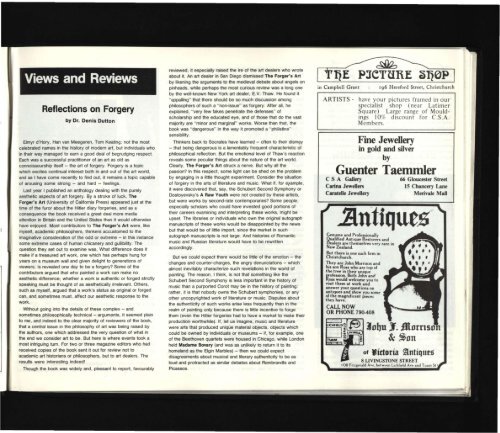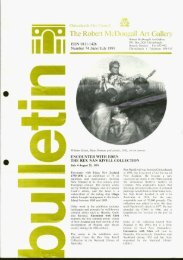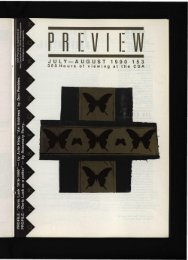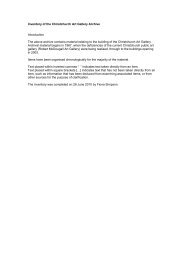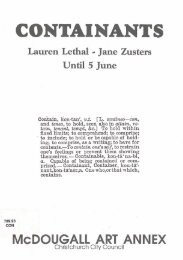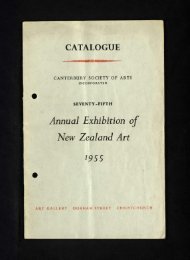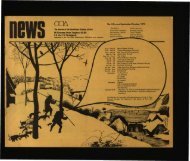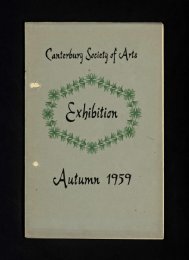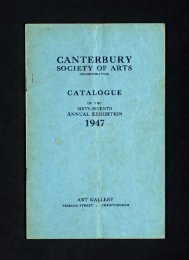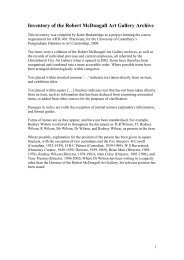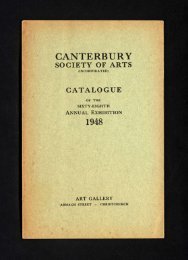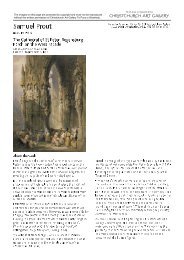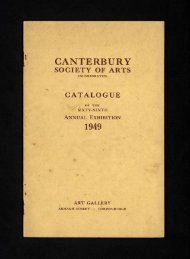Download (6.2 MB) - Christchurch Art Gallery Te Puna O Waiwhetu
Download (6.2 MB) - Christchurch Art Gallery Te Puna O Waiwhetu
Download (6.2 MB) - Christchurch Art Gallery Te Puna O Waiwhetu
Create successful ePaper yourself
Turn your PDF publications into a flip-book with our unique Google optimized e-Paper software.
Views and Reviews<br />
Reflections on Forgery<br />
by Or. Denis Dutton<br />
Elmyr d'Hory, Han van Meegeren, Tom Keating: not the most<br />
celebrated names in the history of modern art, but individuals who<br />
in their way managed to earn a good deal of begrudging respect.<br />
Each was a successful practitioner of an art as old as<br />
connoisseurship itself - the art of forgery. Forgery is a topic<br />
which excites continual interest both in and out of the art world,<br />
and as I have come recently to find out, it remains a topic capable<br />
of arousing some strong - and hard - feelings.<br />
Last year I published an anthology dealing with the purely<br />
aesthetic aspects of art forgery. By a stroke of luck, The<br />
Forger's <strong>Art</strong> (University of California Press) appeared just at the<br />
time of the furor about the Hitler diary forgeries, and as a<br />
consequence the book received a great deal more media<br />
attention in Britain and the United States than it would otherwise<br />
have enjoyed. Most contributors to The Forger's <strong>Art</strong> were, like<br />
myself, academic philosophers, thinkers accustomed to the<br />
imaginative consideration of the odd or extreme - in this instance<br />
some extreme cases of human chicanery and gullibility. The<br />
question they set out to examine was, What difference does it<br />
make if a treasured art work, one which has perhaps hung for<br />
years on a museum wall and given delight to generations of<br />
viewers, is revealed one day to be a forgery? Some of the<br />
contributors argued that who painted a work can make no<br />
aesthetic difference; whether a work is authentic or forged strictly<br />
speaking must be thought of as aesthetically irrelevant. Others,<br />
such as myself, argued that a work's status as original or forged<br />
can, and sometimes must, affect our aesthetic response to the<br />
work.<br />
Without going into the details of these complex - and<br />
sometimes philosophically technical - arguments, it seemed plain<br />
to me, and indeed to the clear majority of reviewers of the book,<br />
that a central issue in the philosophy of art was being raised by<br />
the authors, one which addressed the very question of what in<br />
the end we consider art to be. But here is where events took a<br />
most intriguing turn. For two or three magazine editors who had<br />
received copies of the book sent it out for review not to<br />
academic art historians or philosophers, but to art dealers. The<br />
results were interesting indeed!<br />
Though the book was widely and, pleasant to report, favourably<br />
reviewed, it especially raised the ire of the art dealers who wrote<br />
about it. An art dealer in San Diego dismissed The Forger's <strong>Art</strong><br />
by likening the arguments to the medieval debate about angels on<br />
pinheads, while perhaps the most curious review was a long one<br />
by the well-known New York art dealer, E.V. Thaw. He found it<br />
"appalling" that there should be so much discussion among<br />
philosophers of such a "non-issue" as forgery. After all, he<br />
explained, "very few fakes penetrate the defenses" of<br />
scholarship and the educated eye, and of those that do the vast<br />
majority are "minor and marginal" works. Worse than that, the<br />
book was "dangerous" in the way it promoted a "Philistine"<br />
sensibility.<br />
Thinkers back to Socrates have learned - often to their dismay<br />
- that being dangerous is a lamentably frequent characteristic of<br />
philosophical reflection. But the emotional level of Thaw's reaction<br />
reveals some peculiar things about the nature of the art world.<br />
Clearly, The Forger's <strong>Art</strong> struck a nerve. But why all the<br />
passion? In this respect, some light can be shed on the problem<br />
by engaging in a little thought experiment. Consider the situation<br />
of forgery in the arts of literature and music. What if, for example,<br />
it were discovered that, say, the Schubert Second Symphony or<br />
Dostoyevsky's A Raw Youth were not created by these artists,<br />
but were works by second-rate contemporaries? Some people,<br />
especially scholars who could have invested good portions of<br />
their careers examining and interpreting these works, might be<br />
upset. The libraries or individuals who own the original autograph<br />
manuscripts of these works would be disappointed by the news<br />
but that would be of little import, since the market in such<br />
autograph manuscripts is not large. And histories of Romantic<br />
music and Russian literature would have to be rewritten<br />
accordingly.<br />
But we could expect there would be little of the emotion - the<br />
changes and counter-charges, the angry denunciations - which<br />
almost inevitably characterize such revelations in the world of<br />
painting. The reason, I think, is not that something like the<br />
Schubert Second Symphony is less important in the history of<br />
music than a purported Corot may be in the history of painting:<br />
rather, it is that nobody owns the Schubert symphonies, or any<br />
other uncopyrighted work of literature or music. Disputes about<br />
the authenticity of such works arise less frequently than in the<br />
realm of painting only because there is little incentive to forge<br />
them (even the Hitler forgeries had to have a market to make their<br />
production worthwhile). If, let us imagine, music and literature<br />
were arts that produced unique material objects, objects which<br />
could be owned by individuals or museums - if, for example, one<br />
of the Beethoven quartets were housed in Chicago, while London<br />
held Madame Bovary (and was as unlikely to return it to its<br />
homeland as the Elgin Marbles) - then we could expect<br />
disagreements about musical and literary authenticity to be as<br />
loud and protracted as similar debates about Rembrandts and<br />
Picassos.<br />
tip: P3CT3RE §T)0P<br />
i Campbell Grant 196 Hereford Street, <strong>Christchurch</strong><br />
ARTISTS - have your pictures framed in our<br />
specialist shop (near Latimer<br />
Square) Large range of Mouldings<br />
10% discount for C.S.A.<br />
Members.<br />
Fine Jewellery<br />
in gold and silver<br />
Guenter Taemmler<br />
by<br />
C S A <strong>Gallery</strong><br />
66 Gloucester Street<br />
Carina Jewellers<br />
Caratelle Jewellery<br />
15 Chancery Lane<br />
Merivale Mall<br />
Antiques 1<br />
Genuine and Professionally<br />
ualified Antique Restorers and<br />
Healers are themselves very rare in<br />
New Zealand.<br />
But t here is one such firm in<br />
<strong>Christchurch</strong>.<br />
They are John Morrison and<br />
his son Ross who are top of<br />
the tree in their unique<br />
profession. Both John and<br />
Ross would welcome you to<br />
visit them at work and<br />
answer your quest ions on<br />
antiques and show you some<br />
of the magnificent piecec<br />
they have.<br />
CALL NOW<br />
OR PHONE 790-408<br />
UCMHeiO°<br />
5 UVIWGt?<br />
of Victoria &ntiqueg<br />
8 LIVINGSTONE STREET<br />
(Oil Fil2gerald Ave, between Lichfield Ave and Tuam Si


